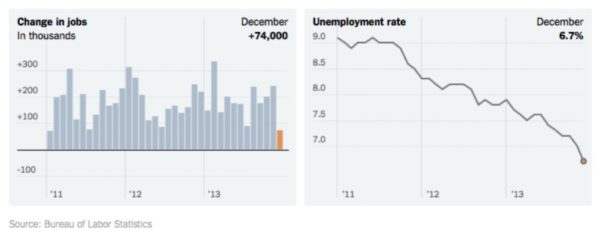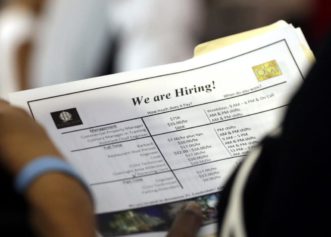The U.S. economy added a mere 74,000 jobs in December, the lowest monthly gain in more than three years. While the unemployment rate is still on a steady decline, reports revealed that the drop is due to a decreasing number of citizens actively seeking work, rather than more jobs being provided.
According to the Labor Department, the unemployment rate fell from 7 percent in November to 6.7 percent in December, and the 74,000 new jobs came in far below the monthly average of 214,000 a month.
Several U.S. economists describe the December numbers as “troubling” and “ugly,” but they also predict that the state of the job market may not actually be as bleak as the report makes it out to be.
“It’s an ugly report,” economist Guy Berger said. “We’re still digging through it, but it’s hard to explain the magnitude of the miss… You do get misses like this every once in a while.”
Berger said it’s likely that the number of new jobs will bounce right back to the monthly average at the end of January.
While the actual state of the economy may not be in any immediate danger, the Department of Labor is still concerned about the growing number of people who have stopped looking for work.
The unemployment rate only includes Americans who are actively seeking employment and this portion of the population has dropped to 62.8 percent, the lowest it has been in more than three decades. This suggests that more than 37 percent of jobless adults who are able to work, are not actively seeking employment.
But chief economic correspondent for Politico, Ben White, tweeted that Americans shouldn’t overreact to the report because there is still sufficient evidence that the economy is improving.
“Every other piece of data we have suggests a strengthening economy,” he tweeted. “No reason to think this one report changes that.”
Ian Shepherdson, economist for Pantheon Macroeconomics, referred to December’s job growth report as a “statistical outlier” and has even recommended that his clients “ignore the wild payroll number.”

Construction firms were forced to cut 16,000 jobs in December, one of the largest cuts in the construction industry in 20 months.
Several other industries also had to cut thousands of positions, which led to the low number of new jobs being created in December.
Last month the government cut 13,000 jobs and health care saw its first decline in jobs in 10 years after cutting 6,000 positions.
Transportation and warehousing jobs saw the smallest job cuts, while retail had an impressive gain in new positions.


